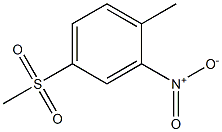5-Nitro-1,10-phenanthroline
Synonym(s):Nitroferroin
- CAS NO.:4199-88-6
- Empirical Formula: C12H7N3O2
- Molecular Weight: 225.2
- MDL number: MFCD00004981
- EINECS: 224-097-6
- SAFETY DATA SHEET (SDS)
- Update Date: 2024-12-18 14:15:30

What is 5-Nitro-1,10-phenanthroline?
Chemical properties
Light yellow to yellow-brown crystalline powder
The Uses of 5-Nitro-1,10-phenanthroline
5-Nitro-1,10-phenanthroline complexes of iron find wide applications in redox titrations. It is used as a precursor for the synthesis of 5-amino-1,10-phenanthroline, 5-isothiocyanato-1,10-phenanthroline.
Biochem/physiol Actions
Platinum chelates of a variety of 5-substituted phenanthrolines, including this compound, were tested for cytotoxicity against L1210 murine leukemia cells. Though all tested compounds had very similar DNA-binding affinities, they exhibited a wide range of cytotoxicity.
Purification Methods
Crystallise the phenanthroline from *benzene/pet ether, until anhydrous. It also crystallises from H2O with m 202o, and EtOAc with m 203o. Its pK2 5 varies from 3.20 to 2.69 with varying MeOH/H2O ratios from 0 to 0.95 moles/L, and from 3.20 to 1.95 in varying EtOH/H2O ratios from 0 to 0.94 moles/L [Ram et al. J Prakt Chem 319 719 1977]. It forms complexes with Cu2+, Zn2+, In2+, Fe2+ , Co2+, Ni2+ . [Beilstein 23 III/IV 1682, 23/8 V 425.]
Properties of 5-Nitro-1,10-phenanthroline
| Melting point: | 202-204 °C(lit.) |
| Boiling point: | 366.71°C (rough estimate) |
| Density | 1.2844 (rough estimate) |
| refractive index | 1.5700 (estimate) |
| storage temp. | Sealed in dry,Room Temperature |
| solubility | soluble in Alcohol,Benzene |
| form | crystalline |
| pka | pK1:3.232(+1) (25°C) |
| color | yellow to orange |
| Water Solubility | insoluble |
| BRN | 196245 |
| CAS DataBase Reference | 4199-88-6(CAS DataBase Reference) |
| EPA Substance Registry System | 1,10-Phenanthroline, 5-nitro- (4199-88-6) |
Safety information for 5-Nitro-1,10-phenanthroline
| Signal word | Warning |
| Pictogram(s) |
 Exclamation Mark Irritant GHS07 |
| GHS Hazard Statements |
H315:Skin corrosion/irritation H319:Serious eye damage/eye irritation H335:Specific target organ toxicity, single exposure;Respiratory tract irritation |
| Precautionary Statement Codes |
P261:Avoid breathing dust/fume/gas/mist/vapours/spray. P264:Wash hands thoroughly after handling. P264:Wash skin thouroughly after handling. P271:Use only outdoors or in a well-ventilated area. P280:Wear protective gloves/protective clothing/eye protection/face protection. P302+P352:IF ON SKIN: wash with plenty of soap and water. P305+P351+P338:IF IN EYES: Rinse cautiously with water for several minutes. Remove contact lenses, if present and easy to do. Continuerinsing. |
Computed Descriptors for 5-Nitro-1,10-phenanthroline
New Products
(S)-3-Aminobutanenitrile hydrochloride 4-Methylphenylacetic acid N-Boc-D-alaninol N-BOC-D/L-ALANINOL Tert-butyl bis(2-chloroethyl)carbamate 3-Morpholino-1-(4-nitrophenyl)-5,6-dihydropyridin- 2(1H)-one Furan-2,5-Dicarboxylic Acid Tropic acid 1-Bromo-3,5-Di-Tert-Butylbenzene S-2-CHLORO PROPIONIC ACID ETHYL ISOCYANOACETATE 2-Bromo-1,3-Bis(Dimethylamino)Trimethinium Hexafluorophosphate 4-IODO BENZOIC ACID 3-NITRO-2-METHYL ANILINE 1-(2,4-DICHLOROPHENYL) ETHANAMINE (2-Hydroxyphenyl)acetonitrile 4-Bromopyrazole 2-(Cyanocyclohexyl)acetic acid 4-methoxy-3,5-dinitropyridine 1-(4-(aminomethyl)benzyl)urea hydrochloride 2-aminopropyl benzoate hydrochloride diethyl 2-(2-((tertbutoxycarbonyl)amino) ethyl)malonate tert-butyl 4- (ureidomethyl)benzylcarbamate Ethyl-2-chloro((4-methoxyphenyl)hydrazono)acetateRelated products of tetrahydrofuran








You may like
-
 5-Nitro-1,10-phenanthroline CAS 4199-88-6View Details
5-Nitro-1,10-phenanthroline CAS 4199-88-6View Details
4199-88-6 -
 5-Nitro-1,10-phenanthroline CAS 4199-88-6View Details
5-Nitro-1,10-phenanthroline CAS 4199-88-6View Details
4199-88-6 -
 1975-50-4 98%View Details
1975-50-4 98%View Details
1975-50-4 -
 2-HYDROXY BENZYL ALCOHOL 98%View Details
2-HYDROXY BENZYL ALCOHOL 98%View Details
90-01-7 -
 2-Chloro-1,3-Bis(Dimethylamino)Trimethinium Hexafluorophosphate 221615-75-4 98%View Details
2-Chloro-1,3-Bis(Dimethylamino)Trimethinium Hexafluorophosphate 221615-75-4 98%View Details
221615-75-4 -
 61397-56-6 CIS BROMO BENZOATE 98%View Details
61397-56-6 CIS BROMO BENZOATE 98%View Details
61397-56-6 -
 14714-50-2 (2-Hydroxyphenyl)acetonitrile 98+View Details
14714-50-2 (2-Hydroxyphenyl)acetonitrile 98+View Details
14714-50-2 -
 118753-70-1 98+View Details
118753-70-1 98+View Details
118753-70-1